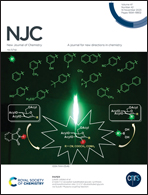Synthesis, gene transfection efficiency, and serum compatibility of β-sitosterol-based cationic lipids with different headgroups†
Abstract
We report syntheses, gene delivery, and physicochemical properties of twelve plant sterol (β-sitosterol)-based cationic lipids with eight types of headgroups. In these lipid molecules, the cationic headgroup and the β-sitosterol tail were joined by a carbamate linkage. The synthesized cationic lipids were formulated into liposomes with helper lipid dioleoylphosphatidyl ethanolamine (DOPE). The physical and DNA-binding properties of the liposomes were characterized, and their formulations were optimized for cell transfection. We found that liposomes prepared from cationic 1B, which has the sperminium headgroup, had the highest transfection efficiency comparable to that of commercial transfection reagent Lipofectamine™ 2000 (L2K). The particle size and the zeta potential of the optimal 1B liposomes were 360 ± 30 nm and 49 ± 10 mV, respectively. Importantly, the liposome 1B had low toxicity, possibly due to the biodegradability of all of its components – the headgroup, the linker, and the tail. In addition, cationic liposome 1B can effectively protect DNA from degradation in the presence of serum, thus enabling high transfection efficiency in the presence of up to 40% fetal bovine serum.



 Please wait while we load your content...
Please wait while we load your content...